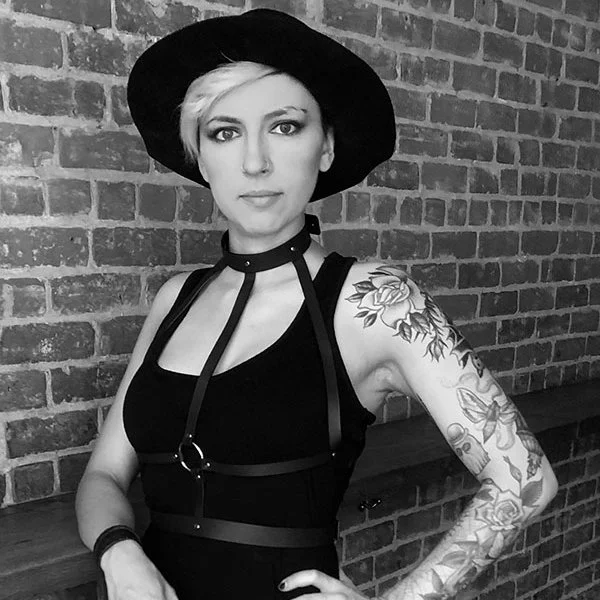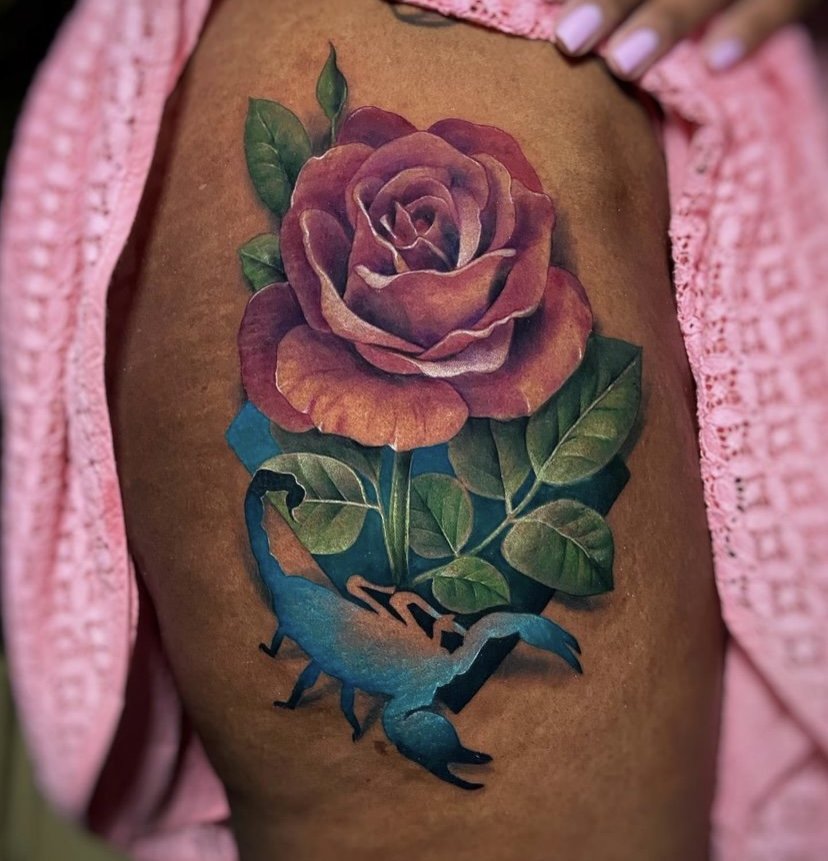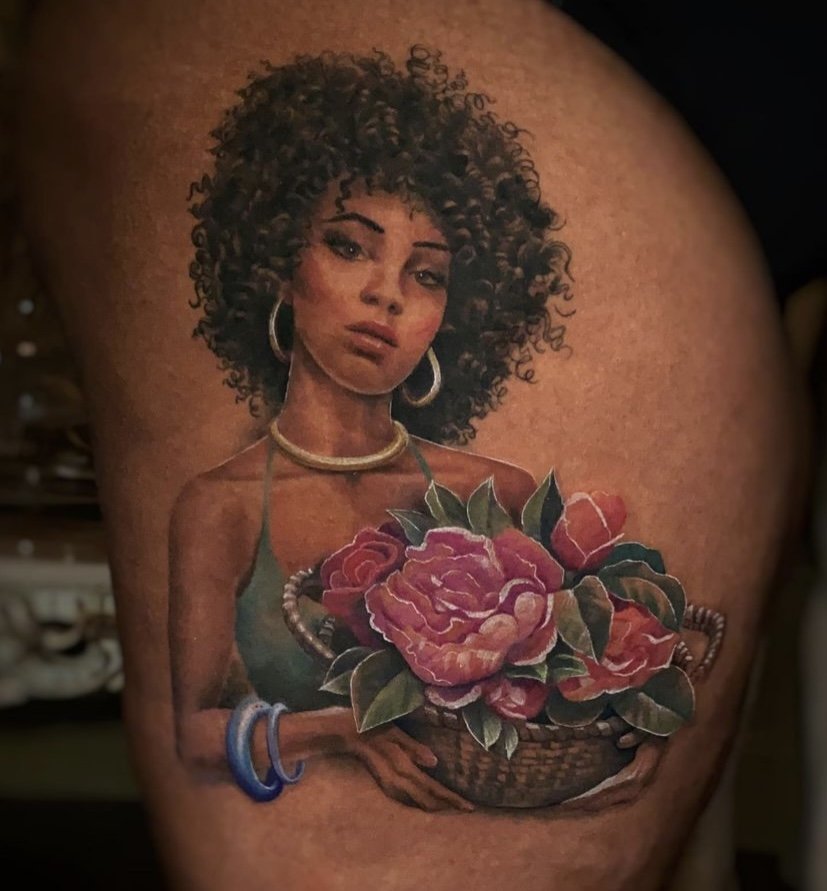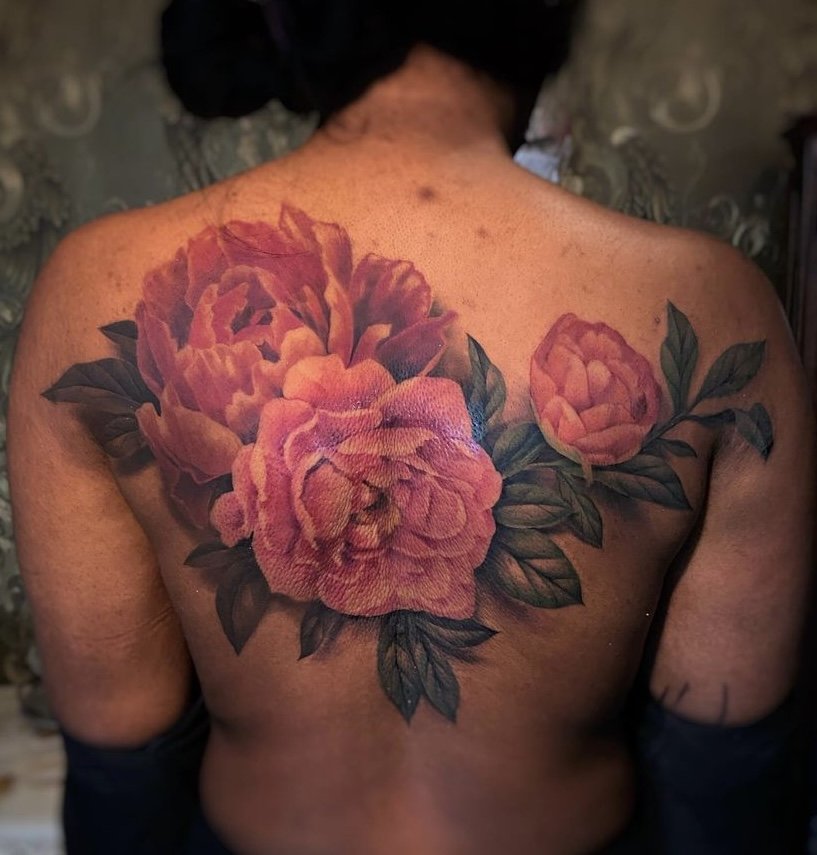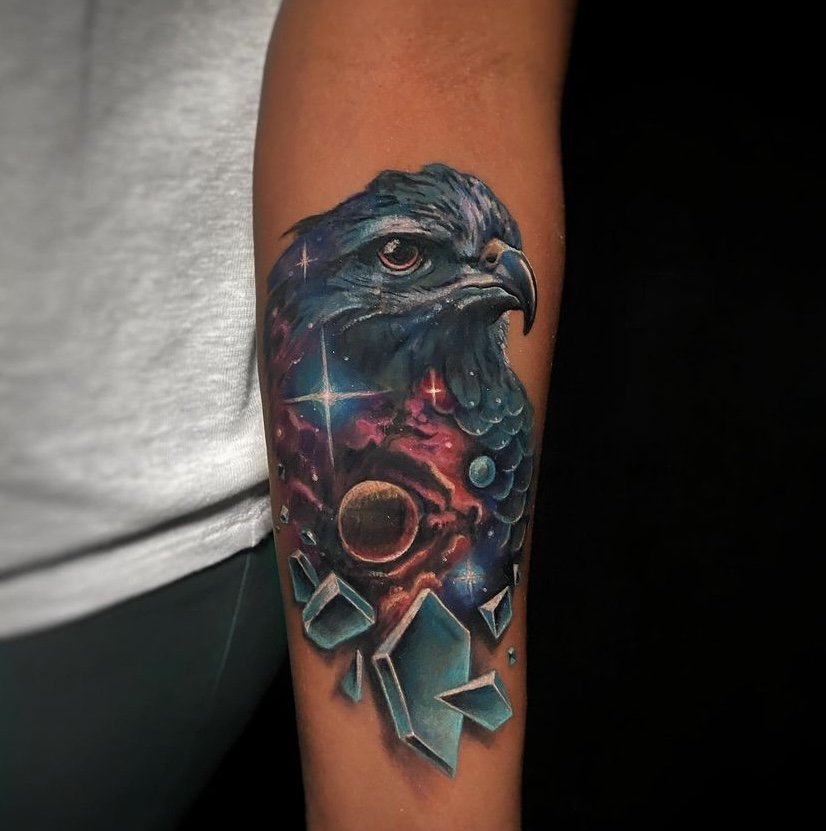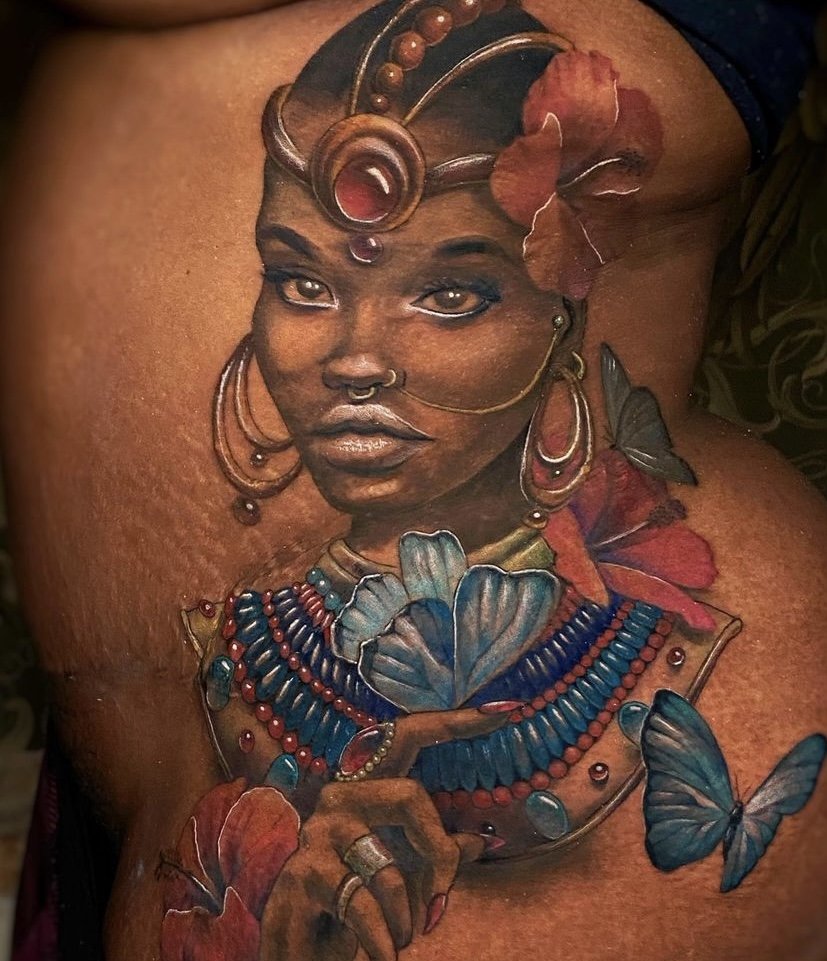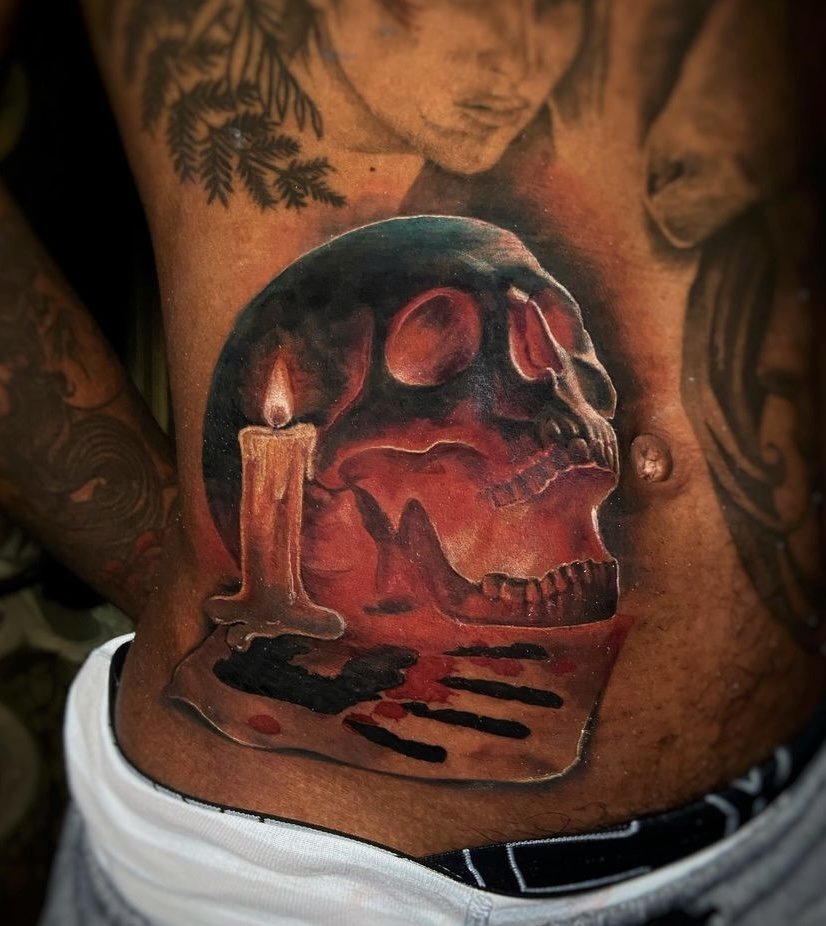Colorwork Tattooing on Darker Skin Tones with Adriana Hallow
If you are immersed in tattoo culture, whether it be as an artist or customer, you have probably heard some form of stereotype involving tattoos on darker skin: “tattoos don’t look good on dark skin,” “color tattoos don’t show up on dark skin,” and so on. In case you didn’t already know, these statements are FALSE! Gorgeous tattoo work is possible on ALL skin tones, regardless of the color palette, and style.
To help gain a better understanding of colorwork fundamentally, and the harsh injustices that it can pose for darker skinned clients, we sat down with tattoo artist, Adriana Hallow (she/her). Based in New York City, Adriana has been a professional tattoo artist since 2015, and is currently a resident artist at Inkology Art Gallery. Despite her personal goth aesthetic, Adriana specializes in very vibrant and colorful illustrative realism tattoos. Her tattoo work holds notoriety for its whimsical appearance(s), with the subjects typically being florals, fantasy imagery, and portraits!
As a queer tattoo artist, Adriana has a deep passion for equal representation within the tattoo world in all ways: LGBTQ+, BIPOC, body positivity. Much like Tattd, her work and presence is actively pushing for a better, more accepting community in this industry, and we are incredibly honored to have the opportunity to chat with her today!
“I love how tattoos can help people feel more like themselves, reclaim their bodies after physical and/or emotional trauma or simply make statements” - Adriana Hallow
Tell us more about the fundamentals of colorwork tattooing!
Adriana: In terms of application, black and grey uses black ink in different concentrations, aka “washes” to create different tonal values by allowing more or less skin to show through, depending on much black ink is deposited on skin. I like to compare it to drawing with charcoal or pencils on paper. Color tattooing on the other hand is more similar to painting with acrylics, in the sense that pigments in color work are never really used as “washes,” but rather applied directly on skin in their full concentration, relying on blending and different stroke techniques to create different values and shades on skin instead. It is important to understand how light gets filtered by our skin and how that affects how we perceive color, in order to fully master how to apply color on skin. It’s not just about color, it’s about physics.
Does the application process of packing color into the skin change based on the actual color of the ink? For example, does yellow require more attention when applying than red or blue?
Adriana: Different pigments have different thicknesses and compositions, making it certainly harder to apply onto skin. Some lighter colors are harder to see if the skin is bleeding. Inexperienced artists are likely to overwork the skin with tricky pigments, but the technique is not necessarily different.
When tattooing in color, artists will frequently mix colored inks together to create different shades, which is also know as "color mixing." What are the basics of mixing colored inks together?
Adriana: You must understand color theory and understand the compositions of your inks, just like when you’re mixing paint. That would be way too long to explain on here, but there are 2 key points: primary colors are magenta, cyan, and yellow, and every color has 3 properties: hue, value and chroma.
Hue is commonly described as color is the wavelength, value is how light or dark and chroma is also called saturation or intensity or purity. Once you understand these 3 concepts you can mix any color.
If I don’t have the exact color I need already in bottle, I mix my inks in the tube to create seamless blends, by simply dipping my needle into whatever color I need to pull any color closer to the hue, value or chroma I’m trying to achieve. For example, if I need to make a red color darker I can mix in some black. If I need to maintain the value but make it more “muted,” aka lower chroma, I may mix it with a grey of the same value. If I need to use a color in full chroma, I may get a new needle to ensure it won’t get contaminated with another color like green that will mute or alter its hue.
Does the healing process and aftercare recommendations for colorwork tattoos differ from that of black and grey?
Adriana: Since color generally pokes more holes in the skin because of the amount of saturation one must achieve, naturally color tattoos push out more plasma than black and grey tattoos. Other than that, it’s not much different.
There is an undeniable stigma surrounding tattooing color on darker skin. As an artist that tattoos color on darker skin tones, what do you think of this? And what do you believe could be a possible solution to break this stigma in the industry?
Adriana: I think it’s time we start viewing all skin with the same value. I’ve heard a lot of artists complain when they get canvases with tan skin and basically be disappointed as if the tattoo is suddenly not going to be as cool or as impressive because it’s on melanated skin. I’ve heard others saying that their style just doesn’t work on dark skin. And there are artists who all they have heard is “color doesn’t work on dark skin” and simply never challenged this belief. This needs to stop. Any style can be adjusted to any body. Our job as tattoo artists is not to judge what good or bad skin is, but rather know how to tattoo all types of skin. I think that it will start with reframing the way we as artists value our work and value our canvases. The emphasis should be on the tattoo itself, not the canvas.
We know there are still artists that turn away darker skinned clients, and we hope it’s because they're not confident in tattooing color on darker skin, rather than due to pure bias. What advice would you give to an artist that wants to educate themselves further on how to serve darker skinned clients better?
Adriana: There is no comprehensive information about it out there that I could find, so I actually have an online seminar going in depth about how to apply color on all skin tones coming out in the fall because to this day I haven’t seen anything like it. So, I decided to make my own to help other artists out there and raise awareness.
First thing is to stop thinking that tattooing dark skin is really that different, because it’s not.
A good place to start however is to get clients in, be honest with them, letting them know you are not as experienced. Most darker skin clients in my experience are generally just relieved and thankful. I never set out to be known in the industry for dark skin, it all just happened because I said yes, without hesitation. And then I kept hearing the same story over and over again of clients getting denied the tattoo they wanted because of the color of their skin. It never made sense to me to turn them away. And 7 years later, these tattoos are still vibrant so I just kept on doing it. It did take some trial and error for sure, understanding what colors looked the best when healed. But you can always offer a color test first, tattoo a series of small dots or lines, perhaps one thing that can be covered by a larger tattoo later and see what it looks like healed after 1-6 months. That will start to give you a good basic understanding.
What advice would you give a dark skinned person that wants a colorwork tattoo, but is too afraid to get one due to the stereotype that "darker skinned people can't get color tattoos?"
Adriana: Go for it! However, Avoid cooler tones like blue and purple and stick to warmer tones like teal, green, yellow, orange, red and pink. Make sure that the design has black and open areas of skin for contrast.
Also, you can get a color test so you see what the colors looks like on your skin tone. This could be in the form of a rainbow or small dots or lines; something that could possibly be covered up later with a larger tattoo. Wait 3-6 months to see the ink fully settled.
You may want to apply the tattoo on an area that doesn’t see as much sun, like the inside of the arm, your torso or upper thigh to prevent the colors from fading over the years. These areas are also generally naturally lighter which would allow the colors to appear more vibrant.
Building off of the previous question, what should a darker skinned person look for when choosing an artist for their colorwork tattoo? Are there any ways to recognize an artist’s quality of colorwork on dark skin when browsing portfolios?
Adriana: A good attitude to begin with. More specifically, you need to look for artist who’s healed work looks clean, that means work that looks as close as possible to the fresh work as this is proof of a sound technical application. You also want to look for healed photos without any scarring, like raised line work. Any healed photos are usually a good indication, as I wouldn’t trust an artist that doesn’t post any healed work. We sometimes forget when it comes to tattoos, what’s important is what it looks like when they are healed, not when they are fresh.
Before we let you go, is there anything else you'd like to add about the topics discussed above?
Adriana: Thanks for doing this! [The Instagram page] @blackartistry101 has a great platform and directory of artists that are experienced with dark skin, as well as @darkskintattootips and @darkskinbodyart!
Special thanks to Adriana Hallow for chatting with us today! If you want to see more of Adriana and her beautiful work, check out her links below:

